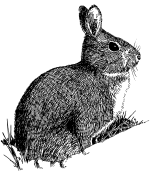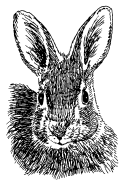 |
Most of the bunnies you see in Michigan are the Eastern Cottontail(Sylvilagus floridanus). They have speckled brown-gray fur, big eyes, and a tail that is puffy white on the underside. Many people believe mistakenly that wild rabbits and domesticated pet rabbits are the same species, but the domesticated rabbit (Oryctolagus cuniculus) belongs to another genus and is only distantly related.
 Domestic rabbits are descended from European wild rabbits and not North American Eastern cottontails. Even if you can’t tell them apart, they know the difference. If a cottontail meets a domestic rabbit, they would probably not even recognize him as a rabbit. Cottontails and domestic (or European) rabbits are genetically isolated and cannot interbreed. Cottontails only live in North and South America and there are 13 currently recognized species, including our eastern cottontail.
Domestic rabbits are descended from European wild rabbits and not North American Eastern cottontails. Even if you can’t tell them apart, they know the difference. If a cottontail meets a domestic rabbit, they would probably not even recognize him as a rabbit. Cottontails and domestic (or European) rabbits are genetically isolated and cannot interbreed. Cottontails only live in North and South America and there are 13 currently recognized species, including our eastern cottontail.Famous for their breeding abilities, cottontails breed from February through September in Michigan. Gestation is about 28 days. Three to four litters of four or five babies are born each year. Young are born helpless in a shallow depression lined with grass and mother's fur, but they grow rapidly and are weaned when less than half the size of the adult.
 |
Please note, many baby cottontails appear to be abandoned, but in fact their mother is nearby. The mother rabbit only visits the nest once or twice a day, and stays well away the rest of the time so it won't attract predators.
Rabbits may live up to two years in the wild, but where predators are numerous they seldom survive more than one year. Hawks and owls are some avian predators, and foxes, raccoons, skunks, and opossums are some mammals that prey on rabbits.
If you think you’ve found an abandoned baby, call a licensed rehabilitator. For a complete list of Michigan Licensed Rehabilitators visit the Michigan Department of Natural Resources at:http://www.michigandnr.com/dlr/
Source: Sargent, M.S and Carter, K.S., ed. 1999. ManagingMichiganWildlife: A Landowners Guide. Michigan United Conservation Clubs, East Lansing, MI. 297pp.
Related Articles:
- When do bats hibernate? http://bit.ly/vvaTGn
- Do Voles Hibernate? http://bit.ly/rTcbQI
- When do Chipmunks hibernate? http://bit.ly/uGhBOB
- Do opossums hibernate during winter? http://bit.ly/u4ORP6
- Migration vs. Hibernation http://bit.ly/sixWTH
- Feb. 2nd groundhogs end their hibernation http://bit.ly/vPHVtx
- Do skunks hibernate? http://bit.ly/xVKDXP
No comments:
Post a Comment